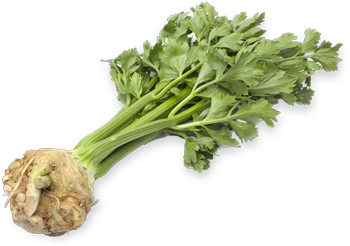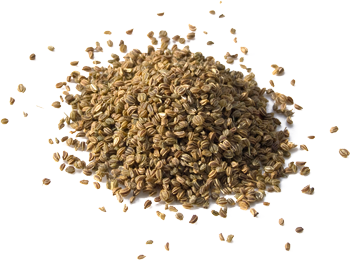חלק הצמח | איכויות | רכיבים פעילים | התוויות | מינונים | רגישות | תופעות לוואי |
מינון יתר | אזהרות | התוויות נגד | רעילות | אינטראקציות | הריון | הנקה
כרפס (סלרי) הינו עשב חד שנתי שמוצאו באגן הים התיכון.
הוא נפוץ בישראל ומשמש כצמח מאכל ותבלין. השימוש הרפואי נעשה בזרעים.
סלרי מותר לשיווק בישראל.

חלק הצמח בשימוש
זרעים
איכויות
טעם: מריר, מתקתק, מלוח.
טמפרטורה: חמים.
לחות: יבש.
רכיבים פעילים עיקריים
שמן נדיף (1.5-3%) המכיל מונוטרפנים, ססקוויטרפנים, פוראנוקומארינים (פסורלנים).
התוויות
שיגדון (גאוט), דלקת מפרקים שגרונית, בצקות, לחץ דם גבוה, דלקות בדרכי השתן.

מינונים
תמצית נוזלית בריכוז 1:3, 60% אלכוהול – 7-14 מ"ל ביום.
חליטה – 3-12 גרם ביום.
בפורמולה – 20%-30%.
רגישות
לעתים נדירות ביותר יכולה להופיע תגובה אלרגית(1-3).
הצמח לא מומלץ לשימוש בקרב אנשים בעלי אלרגיות ידועות לצמחים ממשפחת הסוככיים.
בסלרי קיימים חומרים (פוראנוקומארינים) אשר עלולים להגביר רגישות לשמש או לקרינת UV, אולם מרבית חומרים אלו נמצאים למידע השלם למנויים
תופעות לוואי ומינון יתר
לא ידועות תופעות לוואי כתוצאה משימוש במינונים רפואיים של סלרי(6).
נטילה פומית של שמן נדיף סלרי בשילוב עם שמן נדיף מנטה עלולה לגרום ל למידע השלם למנויים
אזהרות וצעדי מנע
רצוי להימנע מצריכת סלרי ב למידע השלם למנויים
התוויות נגד
אין להשתמש בתמצית הזרעים או בשמן האתרי במצבים של למידע השלם למנויים
רעילות
מדד רעילותLD50: למידע השלם למנויים
תגובות הדדיות עם תרופות / צמחי מרפא / תוספי תזונה
תרופות לטיפול בתת-תריסיות – למידע השלם למנויים
אוקסורולן (methoxsalen) – תרופה לטיפול במחלות עור כגון פסוראזיס למידע השלם למנויים
תרופות נוגדות קרישה ונוגדי קרישה אחרים – למידע השלם למנויים
תרופות נוגדות דִיכאון ממשפחת ה-SNRI’sי(Venlafaxine) - למידע השלם למנויים
ליתיום - למידע השלם למנויים
הריון
זרעי סלרי נחשבים כממריצי רחם ואסורים לשימוש בתקופת ההריון(10).
יחד עם זאת, למידע השלם למנויים
הנקה
סלרי אפשרי לשימוש בהנקה, אולם למידע השלם למנויים
מקורות
- Ballmer-Weber, B. K., Vieths, S., Luttkopf, D., Heuschmann, P., and Wuthrich, B. Celery allergy confirmed by double-blind, placebo-controlled food challenge: a clinical study in 32 subjects with a history of adverse reactions to celery root. J.Allergy Clin.Immunol. 2000;106(2):373-378. https://www.ncbi.nlm.nih.gov/pubmed/10932083.
- Luttkopf, D., Ballmer-Weber, B. K., Wuthrich, B., and Vieths, S. Celery allergens in patients with positive double-blind placebo-controlled food challenge. J.Allergy Clin.Immunol. 2000;106(2):390-399. https://www.ncbi.nlm.nih.gov/pubmed/10932086.
- Vallier, P., DeChamp, C., Vial, O., and Deviller, P. A study of allergens in celery with cross-sensitivity to mugwort and birch pollens. Clin Allergy 1988;18(5):491-500. https://www.ncbi.nlm.nih.gov/pubmed/3233726.
- Ljunggren, B. Severe phototoxic burn following celery ingestion. Arch.Dermatol. 1990;126(10):1334-1336. https://jamanetwork.com/journals/jamadermatology/article-abstract/552268.
- Gral, N., Beani, J. C., Bonnot, D., Mariotte, A. M., Reymond, J. L., and Amblard, P. [Plasma levels of psoralens after celery ingestion]. Ann.Dermatol.Venereol. 1993;120(9):599-603. https://www.ncbi.nlm.nih.gov/pubmed/8161113.
- Mills. S, Bone K, The Essential Guide to Herbal Safety. Churchill Livingstone, 2005. https://www.elsevier.com/books/the-essential-guide-to-herbal-safety/mills/978-0-443-07171-3.
- May B, Kuntz HD, Kieser M, Kohler S. Efficacy of a fixed peppermint oil/caraway oil combination in non-ulcer dyspepsia. Arzneimittelforschung 1996;46:1149-53. https://www.ncbi.nlm.nih.gov/pubmed/9006790.
- Micklefield GH, Greving I, May B. Effects of peppermint oil and caraway oil on gastroduodenal motility. Phytother Res 2000;14:20-3. https://www.ncbi.nlm.nih.gov/pubmed/10641042.
- May B, Kohler S, Schneider B. Efficacy and tolerability of a fixed combination of peppermint oil and caraway oil in patients suffering from functional dyspepsia. Aliment Pharmacol Ther 2000;14:1671-7. https://www.ncbi.nlm.nih.gov/pubmed/11121917.
- Brinker F. Herb Contraindications and Drug Interactions, 4th ed. Sandy (OR): Eclectic Medical Publications; 2010. https://www.eclecticherb.com/herb-contraindications-drug-interactions
- Tisserand R, Balacs T. Essential Oil Safety: A Guide for Health Care Professionals. Edinburgh: Churchill-Livingston, 1995, 115. https://www.elsevier.com/books/essential-oil-safety/9780443062414.
- British Herbal Medicine Association. British Herbal Compendium, vol. 1. Bournemouth: BHMA; 1992. pp. 56-57. https://bhma.info/index.php/british-herbal-compendium-vol-1/.
- Bisset NG, ed. Herbal Drugs and Phytopharmaceuticals. Stuttgart: Medpharm Scientific Publishers; 1994. pp. 81-82. https://trove.nla.gov.au/work/30952715?q&versionId=41469057
- Opdyke DLJ. Monographs on fragrance raw materials.Food Cosmet Toxicol. 1974;12:849–850. https://www.ncbi.nlm.nih.gov/pubmed/1236824
- Moses G. Thyroxine interacts with celery seed tablets? Australian Prescriber. 2001;24(1):6. https://www.nps.org.au/australian-prescriber/articles/thyroxine-interacts-with-celery-seed-tablets
- Boffa JM, Gilmour E, Ead RD. Celery soup causing severe phototoxicity during PUVA therapy. Br. J. Derm., 135:330-345, 1996. https://www.ncbi.nlm.nih.gov/pubmed/8881693
- Christensen, L. P. and Brandt, K. Bioactive polyacetylenes in food plants of the Apiaceae family: occurrence, bioactivity and analysis. J Pharm.Biomed.Anal. 6-7-2006;41(3):683-693. https://www.ncbi.nlm.nih.gov/pubmed/16520011.
- Heck, A. M., DeWitt, B. A., and Lukes, A. L. Potential interactions between alternative therapies and warfarin. Am.J Health Syst.Pharm. 7-1-2000;57(13):1221-1227. https://www.ncbi.nlm.nih.gov/pubmed/10902065.
- Awortwe C, Makiwane M, Reuter H, Muller C, Louw J, Rosenkranz B. Critical evaluation of causality assessment of herb-drug interactions in patients. Br J Clin Pharmacol. 2018 Apr;84(4):679-693. https://www.ncbi.nlm.nih.gov/pubmed/29363155
- Khalid Z, Osuagwu FC, Shah B, Roy N, Dillon JE, Bradley R. Celery root extract as an inducer of mania induction in a patient on venlafaxine and St John's Wort. Postgrad Med 2016; 128: 682–683. https://www.ncbi.nlm.nih.gov/pubmed/27467225

דוגמא למונוגרף מלא
לרכישת מנוי |
כניסת מנויים







